|
Di seguito gli interventi pubblicati in questa sezione, in ordine cronologico.
While marijuana is known to increase appetite, the study was the first to confirm the effectiveness of its main chemical, THC, in patients with the eating disorder.
Anorexia nervosa affects women more often than men and is caused by an irrational fear of gaining weight, leading to restricted food intake and excessive weight loss.
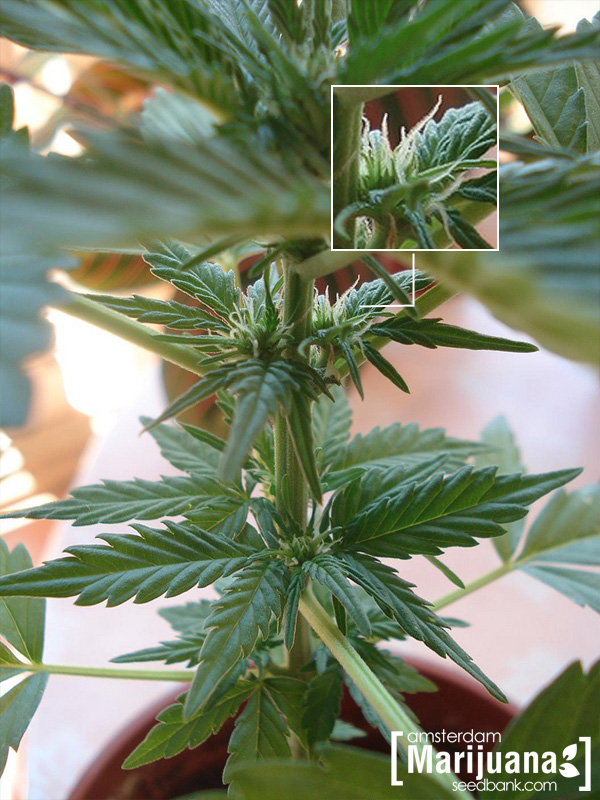
Researchers at the Center for Eating Disorders at Odense University Hospital in Denmark monitored 24 women with severe, long-lasting anorexia nervosa who were given synthetic THC pills (dronabinol) as part of a randomized controlled crossover trial.
The findings were released last month in the International Journal of Eating Disorders.
Dronabinol therapy was well tolerated. During four weeks of exposure it induced a small but significant weight gain in the absence of severe adverse events.
Patients were split into two groups and received 4 weeks of daily dronabinol and placebo in succession, with a 4 week break for washout in between.
On average, patients gained 0.73kg more during the 4 weeks of dronabinol treatment compared with 4 weeks of receiving placebo. While only a modest improvement, the authors suggest that a longer treatment period might produce more significant benefits.
Side effects were not officially measured, but the authors noted minimal adverse reports. Results from the one year follow-up also confirmed the safety of THC therapy.
Weight records collected up to one year after the end of the trial showed that the participants continued to improve their nutritional status without developing addiction or withdrawal symptoms, suggesting that dronabinol was safe in these patients with longstanding AN [anorexia nervosa].
According to the authors, the latest study was the first in over 30 years to investigate THC’s potential in anorexia nervosa. Previous studies on THC and weight gain have only involved patients suffering from anorexia caused by diseases such as cancer and AIDS.
However, because of the small sample size of the study, the authors say that larger studies are needed before THC can be widely recommended as a treatment for anorexia nervosa.
The study was published ahead of print and supported independently by the Center for Eating Disorders, Department of Endocrinology, Odense University Hospital
Source: LeafScience.com
Joint mobilization is a common physiotherapy technique used to treat musculoskeletal pain and dysfunction, especially following surgery. It involves stimulating the joints through passive movements and can be applied to joints in areas such as the ankle or spine.
While the technique has been shown to reduce pain in clinical studies, scientists are still trying to figure out how it works.
Using mouse models of postoperative pain, a team from Brazil, led by Dr. Adair Santos of the Federal University of Santa Catarina, showed for the first time that naturally occurring cannabinoids are involved with the pain-relieving effects of joint mobilization. Their findings were published online in the journal Neuroscience.
“This study represents the first direct demonstration of the role of the endocannabinoid system on the antihyperalgesic effect of ankle joint mobilization.”
By blocking cannabinoid pathways (CB1 and CB2 receptors), the researchers found that the pain-relieving effects of joint mobilization could be reversed. However, pain relief seemed to last longer when the mice were treated with a drug that stopped the breakdown of the body’s own cannabinoids.

According to the authors, the findings are consistent with data from human subjects which show that joint mobilization increases blood levels of anandamide – a natural cannabinoid that mimics the activity of THC.
While more research is necessary, the authors conclude that drugs which inhibit the breakdown of cannabinoids like anandamide could be used to enhance the benefits of joint mobilization in the future.
The study received funding from Conselho Nacional de Desenvolvimento Científico e Tecnológico (CNPq), Fundação de de Amparo à Pesquisa e Inovação do Estado de Santa Catarina (FAPESC), and Coordenação de Aperfeiçoamento de Pessoal de Nível Superior (CAPES), Brazil
Source: LeafScience.com
Most recognize medical marijuana to be helpful for cancer patients in some way or another.
Yet marijuana’s legal status has prevented researchers in many countries from providing thorough evidence. Instead, scientists are limited to studying the effects of chemicals isolated from marijuana (called cannabinoids), which misses the full picture.

Thankfully, cannabis research is taking off in Israel, where medical marijuana is legal.
Just last year, a study involving 200 cancer patients found medical marijuana use led to “significant improvements” across “all” cancer and cancer treatment-related symptoms.
Here’s a list of 10 ways that marijuana seemed to help these patients during their battle with cancer:
1. Nausea and Vomiting
Marijuana may be best known for its ability to reduce nausea and vomiting caused by chemotherapy.
It’s so effective that a pill form of THC (Marinol) has been approved by the FDA for treating chemotherapy-induced nausea and vomiting since 1985.
2. Weight Loss
Along with nausea, patients undergoing chemotherapy often find it hard to maintain normal weight. Thankfully, marijuana has been shown to not only relieve nausea, but stimulate appetite as well.
For patients with cancer, marijuana can help improve food intake and prevent unhealthy loss of weight.
3. Mood
Cancer patients often suffer from mood disorders such as depression.
While it’s no secret that marijuana makes users feel good, research seems to explain why. As many studies have found, chemicals in marijuana appear to have significant anti-anxiety and antidepressant effects.
4. Pain
Another well-known effect of marijuana is pain relief.
And while its benefits seem to span a range of chronic pain disorders, studies show that marijuana can help reduce pain in cancer as well.
5. Sleep
Patients with cancer often suffer from sleep problems, including difficulty falling asleep and maintaining sleep.
On the other hand, sleepiness is one of marijuana’s most commonly reported side effects. THC has also been shown to improve sleep in patients undergoing chemotherapy.
6. Fatigue
Cancer-related fatigue can also cause patients to feel sleepy during the day.
Interestingly, marijuana seems to help patients combat daytime fatigue, while at the same time helping patients get to sleep at night. It’s multi-faceted effect on sleep may depend on the strain of marijuana and the balance of cannabinoids that they contain.
7. Sexual Function
Sexual dysfunction is a common, yet lesser known effect of cancer and cancer therapies.
While findings are inconsistent, marijuana has a long history of use as an aphrodisiac, dating back at least 3,000 years to ancient India.
8. Constipation
Chemicals in marijuana help regulate the digestive system and have been suggested as a treatment for a wide range of bowel disorders.
While marijuana seems to help by reducing bowel movements in inflammatory bowel disorders, it appears to have an opposite effect in constipation.
9. Itching
Itching can be a side effect of various cancers as well as various cancer treatments.
While the underlying causes of itching in cancer patients vary, marijuana seems to help some patients deal with this irritating symptom.
10. Cancer
Perhaps the most promising (and controversial) benefit of marijuana in cancer is the treatment of cancer itself.
While preclinical studies have long supported the ability of marijuana to kill cancer cells and stop the disease from spreading, the medical community argues that human research is lacking.
Still, studies in cell culture and animal models continue to show evidence of a cancer-fighting effect. So much so that major cancer organizations – including the U.S National Cancer Institute and Cancer Research UK – have large sections of their website dedicated to the role of cannabis and cannabinoids in fighting cancer.
Dr. Sean McAllister, of the California Pacific Medical Center Research Institute, is hoping to start human trials involving cannabidiol (CBD) as a treatment for breast cancer. His research shows that CBD can fight breast cancer in cell cultures and rodent models.
Unfortunately, no timeline on human studies has been set.
Source: LeafScience.com
Heightened pain in individuals who are stressed, anxious or depressed is widely recognized by scientists. While the link between mood and pain perception is poorly understood, genetic factors have long been thought to play a part.
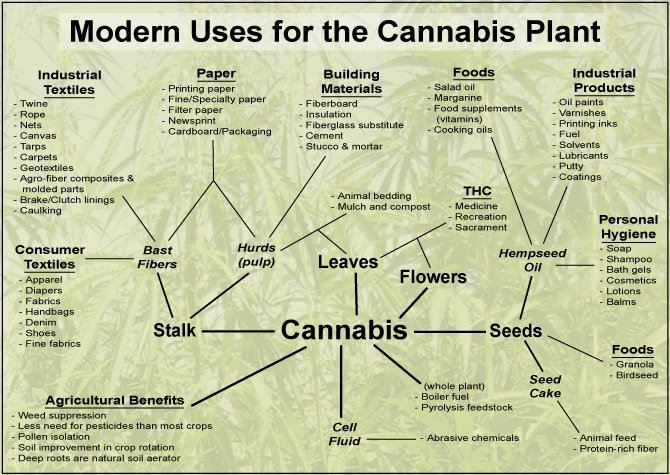
Now researchers have connected a stress-prone genetic background with a dampened response of endocannabinoids – natural chemicals that act to decrease pain – in a region of the brain called the rostral ventromedial medulla. The region is known to play a role in regulating pain.
Dr David Finn, of the Galway Neuroscience Centre and the Centre for Pain Research at the National University of Ireland (NUI), shared his thoughts on the new findings in this press release.
“The link between emotionality and pain is fascinating and highly complex. This research suggests a key role for the brain’s endocannabinoid system in a genetic background prone to heighted stress or negative emotion.”
He adds that the findings could lead to new treatments of pain and stress-related psychiatric disorders.
The study, published online in the journal PAIN, pinpointed CB1 receptors in the rostral ventromedial medulla as a site of action for the brain’s cannabinoid painkillers. CB1 receptors are also activated by THC in marijuana and a responsible for the drug’s psychoactive effects.
Previous studies have also shown a pain-relieving effect of CB1 receptors in this region of the brain. However, Dr. Finn’s study was the first to link irregular endocannabinoid activity in the rostral ventromedial medulla to genetic stress factors.
The authors conclude that reversing the irregular activity may “represent a useful and novel therapeutic approach for the treatment of patients with pain that is exacerbated by negative affect or co-morbid with stress-related psychiatric disorders.”
The study received funding from the Science Foundation Ireland
Source: LeafScience.com
About 40% of HIV infections lead to some sort of brain impairment, such as HIV-1 associated cognitive impairment (HAND) and dementia, according to a team at the school’s Division of Experimental Medicine.
“HIV goes to the brain in an early stage during the HIV infection and causes mostly mild HAND disease,” explains Hava Avraham, Ph.D, who co-authored the new study.
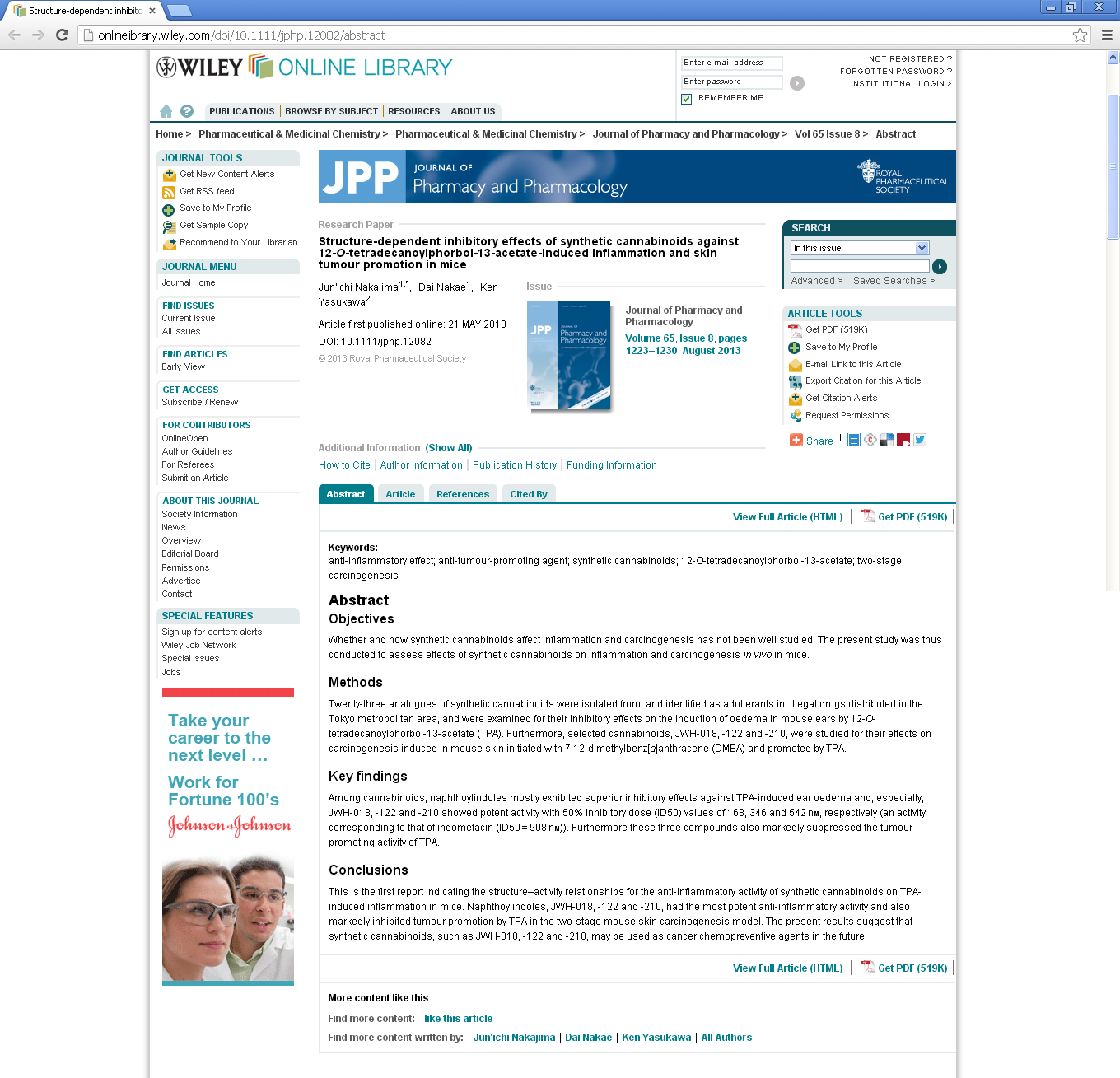
“Although there are quite effective HIV drugs, standard antiretroviral therapy, to treat this stage, many of these drugs cannot cross the blood-brain barrier and therefore cannot really prevent the damage that HIV causes in the brain.”
But cannabinoids can cross the blood-brain barrier and have been shown to protect the brain in a variety of conditions.
In the latest study, published in the British Journal of Pharmacology, Dr. Avraham and her colleagues found that cannabinoids may also offer protection from a toxic protein created by the HIV virus, known as Gp120 protein.
“This molecule (Gp120) crosses the blood-brain barrier and causes a very toxic effect on the brain, especially on neuronal cells, which are very important for the functionality of the brain.”
She adds that a process called neurogenesis plays a key role in the development of the brain’s neurons, which are generated from neural stem cells and progenitor cells.
Using a cannabinoid called AM2421, which acts only on the CB2 receptors of the brain (not CB1), the researchers were able to protect the progenitor and neural stem cells from doses of Gp120, which Dr. Avraham says had “very positive effects on stem cells surviving.”
Experiments in animal models revealed similar results.
“Based on these in vitro studies, we went and analyzed neurogenesis in vivo in the mice brain. The mice were either untreated or treated with AM2421. Then we checked different parameters of neurogenesis and we found very positive results (with AM2421).”
While the researchers focused mainly on the CB2-specific cannabinoid AM2421, Dr. Avraham says cannabinoids that act on CB1 receptors – which are responsible for the marijuana high – were also effective. But like many others, she believes the side effects of CB1 activity could pose a problem in clinical settings.
“We also saw in our in vitro data that CB1 agonists, that we used, also have protective effects. The problem is really whether you can treat patients with CB1 agonists (without) addiction and having some other very significant side effects.”
Dr. Avraham says a number of CB2-specific drugs have already been developed for treating other conditions, and believes that it could be quicker to have them approved for HIV-related impairments.
Interestingly, previous studies suggest that various cannabinoids in marijuana may have positive effects on neurogenesis as well.
Dr. Avraham also believes that her latest findings might have wider implications than HIV, but hopes that further research will be done in order to bring investigators closer to human trials.
The study was funded by the Department of Experimental Medicine at Beth Israel Deaconess Medical Center
Source: LeafScience.com

Section 1: Choosing a space to grow
Choosing a space to grow indoors is just as important as choosing the proper space outdoors. Your garden should be located in an out of the way place (not the bedroom). Basements, attics, and closets are all great places. Once you have a few possibilities in mind make sure the have access to electrical outlets. Plan ahead for anything that might require a repairman to visit your house. If your garden is located in the same room as the furnace, and the furnace explodes, your in big trouble. Once the permanent garden location has been selected it is time to prepare it. (For the rest of this document I will assume you have chosen a closet as the grow space). Paint the walls flat white. Do not use tin foil because it can actually focus light like little laser beams and burn holes through the leaves. Next, cover the floor of the closet with plastic. This will help stop water damage to the floor.
Section 2: Containers
Your plants will need to be grown in some kind of container. Large plastic pots (like the ones bushes come in) work best. Fill the bottom inch with large gravel to help drainage. And the rest with high quality potting soil with some sand mixed in. Buckets can also be used but drill drainage holes in the bottom. If your containers previously held other plants then they must be sterilized with bleach or alcohol.
Section 3: Ligthing
Since there is no sun in your closet you will have to provide a sun loving plant like cannabis with alot of artificial light. There are three options available to the grower: fluorescent lights are cheap, efficient, and don't put out much heat. Metal halide, or MH bulbs, are more expensive but put out much more light than fluorescent. They also put out more heat so ventilation is needed. MH bulbs also require a separate ballast in order to work. High Pressure Sodium lamps, or HPS, put out as much light as MH lamps but with a little less heat. Ventilation and a separate ballast are also required (the ballast regulates the current to the lamps and provides sufficient voltage to start the lamps. Without a ballast to limit its current, a fluorescent lamp connected directly to a high voltage power source would rapidly and uncontrollably increase its current draw. Within a second the lamp would overheat and burn out).
Fluorescent lights
Fluorescent lights are the cheapest light to use. They run at about $2 a tube. They produce little heat so ventilation may not be needed unless the space is very small. The light spectrum put out by these lights is suitable for all stages of growing. Because fluorescents disperse light over a large area, they need to be kept within three inches (8 centimeters) of the tops for the plants to receive enough light. This means you will have to mount the lights in a way that the can be raised everyday.
Metal Halide Lights
Metal halide lamps put out the most light. They also produce a lot of heat. A strong fan is needed to keep room tempertures down. MH lamps put out light mostly in the blue spectrum. Blue light is used best by the plant during vegative growth. MH lights can also be used for flowering with no adverse effects. A separate ballast is required for these lights to work. They come in sizes from 40 to 1000W. One 1000W lamp will provide enough light in a closet to grow four plants.
High Pressure Sodium Lights
High pressure sodium lamps put out almost as much light as MH and with less heat. Good ventilation is still required though. HPS lamps produce light in mostly the red and orange end of the spectrum. The plants uses this light best when flowering. HPS lamps can also be used for vegative growth with little slow down in foliage production. HPS lamps require a separate ballast for operation.
Some growers switch between MH and HPS depending on what stage the plants are in. MH is used in vegative growth and then the light is swithched over to HPS once flowering begins. Most growers use fluorescents to start seedlings and root clones. The fluorescents are weaker than the MH and HPS lamps and therefore do not stress them too much. Choose whatever light is best suited for your situation. If your are growing in your attic go with MH or HPS. If your growing in the closet like us, then use fluorescents. (For the rest of this document I will assume the reader is using fluorescent lighting).
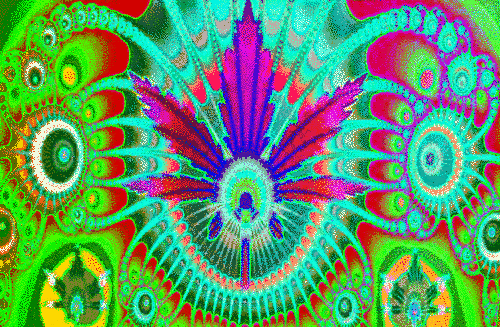
Section 4: Factors affecting the rate of photosynthesis
There are other factors other than the obvious amount of light that reaches the plants that affect the rate of photosynthesis. These can be manipulated by the grower to achieve maximum speed of growth and larger yields in a shorter period of time.
Humidity
The humidity in the enviroment is the amount of water vapor present in the air. Most growers know that humidity in excess of 85% percent increases the probability of the appearance of bud mold. The humidity is also critical during germination when the seedlings are extremely fragile. Humidity should be kept over 80% at this stage in the plants life to prevent the soil from drying too fast. Experimentation has shown that a relative humidity of 65% to 80% increases growth rate. Below this level the plants develop extremely narrow and tissue paper thin leaves to try to prevent excess loss of water. Above 80% relative humidity the plant have trouble disposing of toxic chemicals through evaporation.
Temperature
Cannabis can survive tempertures from 32 degrees Fahrenheit (0 degrees Celsius) to over 100 degrees F (38 degrees Celsius). Cannabis will grow best with a temperture of 70 to 75 degrees F (21 degrees-24 degrees Celsius) day and night. Higher than 90 degrees F (32 degrees Celsius) the enzymes within the plant begin to breakdown and photosynthesis is affected. The same is true for low tempertures.
Carbon dioxide
Carbon dioxide is a gas that is essential for the light reactions in all plants that carry on photosynthesis. CO2 is absorbed through the leafs stomates and is combined with water and light energy to form glucose (used by the plant as energy) and oxygen (which is released). Therefore supplementing CO2 to the existing amount in the air will speed up photosynthesis and therefore, growth will occur faster. Experimentation has also shown that CO2 can help cannabistoloerate higher tempertures (up to 95 degrees F) with little affect on the rate of photosynthesis.
Water
Although only a small portion of water absorbed by the plant is used in photosynthesis a shortage of water does affect the rate photosynthesis occurs. This happens because when the plant is low on water the stomates (In botany, a stoma, plural stomata, occasionally called a stomate, plural stomates: is a pore, found in the epidermis of leaves, stems and other organs that is used to control gas exchange) on the leaves close preventin the release of waste gases and other toxic chemicals. This closure will severely slow down or even stop photosynthesis from occuring.
Section 5: Sea of green
Sea of green, or SOG, is the theory of harvesting many small plants frequently, instead of large plants less frequently. In an SOG setup the closet is divided into two light tight spaces. In the top space the lights are permanently set on a 12/12 light/dark timer. On the bottom the lights are kept on for 18 hours per day. Flourescent lights are used throughout. The bottom shelf is used to start seedlings and root clones. The top shelf is used for flowering. Using this setup harvesting can take place once a month.
Section 6: Ventilation
Cannabis like all other plants puts out waste through the stomata on it's leaves. Outdoors wind, rain and sun are present to evaporate these toxins from the leaf surface. Indoors the grower must create an enviroment. The best way to do this is with a fan of some kind. If the grow room is large enough then an regular cooling fan can be placed inside and left on all the time. If you are running a small closet operation then just opening the door twice a day to look at them will create enough air movement for healthy growth. A fan controlled by a thermostat will also work well. These can be found at most electronics stores.
If a large number of plants are to be kept a dehumidifier may be needed. If humidity levels are too high then the chances of mold will dramaticly increase. A dehumidifier will cost a grower about $100 so it isn't really practical for the closet grower.
Section 7: C02 supplementation
Some growers add C02 to their grow rooms to increase growth rate. This has proved itself to be effective in many experiments. C02 supplementation also helps the plants withstand higher tempertures of up to 95 degrees (35 degrees C) without slowing down growth. There have been complaints however, that C02 supplementation during flowering reduces potency. Therefore, C02 should be stopped when the lights are turned to 12/12.
Section 8: Early sexing
Since you control the light cycle in an indoor operation it is easy to sex the plants early and eliminate all the males. Just turn the lights down to 12/12 when the plants are eight inches (20 centimeters) high. Use a magnifying glass to examine the flowers and eliminate all the males.
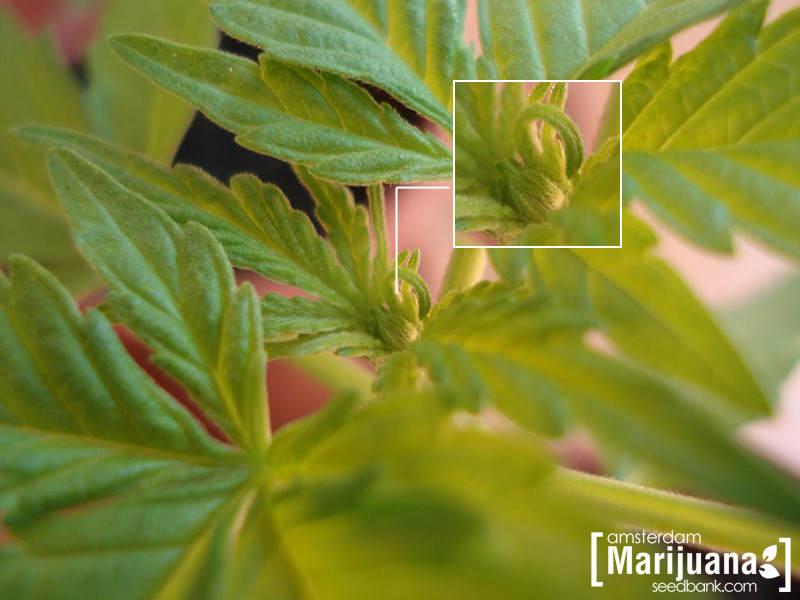
Male marijuana plant
FOR MORE INFORMATION, PLEASE READ THIS ARTICLE: Cannabis Male and Female Marijuana Plants. What's the Difference?
Section 9: Obtaining seed
If you do want to pollenate some females to produce seed for the next crop it can be done so that only a few buds are pollenated and the rest remain as sinsemilla (sinsemilla, plural sinsemillas: A technique of growing cannabis where only the female is allowed to blossom. Without pollen from the male plant, the female blossoms produce no seeds, forming large panicled flowers that have a high content of cannabinoids, found in THC). First collect pollen from a male. The male should show desirable characteristics, like fast growth, potency and resistence to pest and mold. To collect the pollen just shake the branches into a plactic bag. Black paper can also be used to collect pollen. Just lay it on the floor around the plant, in a few days the paper will have quite a bit of pollen on it. The pollen can be stored in film canisters until it is needed. When needed, use a paintbrush to brush on the pollen to the LOWER branches of the female. The best way to be sure that all the seeds are mature before harvest is to just never harvest the pollenated branches. Let them die naturally so you can be sure they produce viable seed.

Here is a female plant. Notice the white hairs.
Section 10: Harvesting and drying
When you want you plants to start flowering just turn the lights down to 12 hours light and 12 hours dark. Then be patient and wait for flowering to complete. It helps the drying process a little if you don't water the week before harvesting. When you cut the plants remove the large fan leaves and add them to your compost pile as they are not usable for smoking. Place the plants in shoe boxes or paper bags and stir them around daily. In about three weeks the buds should be totally dry and ready to smoke.
Source: WeedFarmer - Adnotations by www.TurismoAssociati.it/dBlog - For other information check GrowWeedEasy
...IT CONTINUES. HERE.
Since almost all people have a strong affinity to sex, a sexual subliminal message would be the most effective one. Embedded on a certain product it's supposed to trigger viewers attention, emotions and stir up affinity in him toward the product. Unfortunately, as you're going to see for yourself, this principle has been heavily misused, abused and misapplied. Blatant sexuality on the verge of pornography can be easily found in public advertising, family movies, cartoons and children products.

The famous Farrah Fawcett’s “SEX” in the hair:

This poster had been one of the major urban legends of the late 70s. It was always puzzling why this image in particular became incredibly popular (over 12 millions copies sold). After all, there were plenty of other posters of scantily clad attractive young women.
The word SEX in print media is usually embedded into hair, creases in clothing, facial lines, or rough background surfaces. Often some noise added to disguise it, like in the House snapshot, or it can be spelled as "ssex" or "sexx", etc.
Letter-looking patterns can naturally occur in such mediums. An artist usually looks for these patterns and starts from there. For example in the following Jantzen ad the letter "X" is already formed by the stitches of the man's shirt. Then the shadow of his hand was modified a bit to look like an "E" and the letter "S"—purportedly a water ripple—was lightly painted in the gap under his arm.
A one word guarantee:

Another technique is to write numerous SEXes in interweaving mosaic-like manner on a transparent overlay which can be superimposed onto any photograph at any intensity level desired. So in the next image there are many transparent words SEX written all over her face: forehead, lips, hair, chin etc. That's besides the crown concealing the word SEX in its design.

The Inhabited Island 2. On the 8th minute of the movie slowly moving camera focuses on a wall for about 10 seconds. Quite bluntly the word SEX is etched in the stone. The family picture nearby serves as a camouflage for another word SEX. This is just one of many instances throughout the movie. Ironically, the storyline revolves around ruling elite using covert mind control means to manipulate population for their own designs and here we are: the movie makers use covert mind control means to manipulate the viewer for their own designs.

Click image for animated gif with highlight.
Another interesting technique is embedding of anamorphic images—kind of what you see when you look into a funny mirror at an amusement park or into a shiny coffee pot at home. These distorted, often grotesque images serve as a decoy for the real message which can be hidden within the ground (foliage, flowers, landscapes, reflections in bottles, ice cubes, symbols, and so forth). Although it is not consciously obvious, it may very well be obvious to our subconsciousness and recorded there.
A surprisingly large amount of subliminal death symbolism is also utilized—skulls hidden in ice cubes, clouds, etc., the word DEATH or DETH often hidden in backgrounds.
During the evolutionary development of humans, subliminal perceptions were certainly involved with survival and adjustment. Creative innovators such as artists, poets, writers and composers have utilized man's subliminal potentialities for many centuries. In at least one Rembrandt painting, for example, a hidden SEX appears (spelled as seks in Dutch). Paintings of Monet are also abundant with it.

Source: subliminalmanipulation.blogspot.ro - Author: Jonathan Adampants
The BRITISH EMPIRE is alive and well in "THE CITY" that Rothschild built on the blood and backs of the people. - TruthSeeker The following historical story is taken from a radio address given by Congressman Charles G. Binderup of Nebraska, some 50 years ago and was reprinted in Unrobing the Ghosts of Wall Street: The following historical story is taken from a radio address given by Congressman Charles G. Binderup of Nebraska, some 50 years ago and was reprinted in Unrobing the Ghosts of Wall Street:
Colonies More Prosperous Than The Home Country
Before the American War for Independence in 1776, the colonized part of what is today the United States of America was a possession of England. It was called New England, and was made up of 13 colonies, which became the first 13 states of the great Republic. Around 1750, this New England was very prosperous. Benjamin Franklin was able to write:"There was abundance in the Colonies, and peace was reigning on every border. It was difficult, and even impossible, to find a happier and more prosperous nation on all the surface of the globe. Comfort was prevailing in every home. The people, in general, kept the highest moral standards, and education was widely spread." When Benjamin Franklin went over to England to represent the interests of the Colonies, he saw a completely different situation: the working population of this country was gnawed by hunger and poverty. "The streets are covered with beggars and tramps," he wrote. He asked his English friends how England, with all its wealth, could have so much poverty among its working classes. His friends replied that England was a prey to a terrible condition: it had too many workers! The rich said they were already overburdened with taxes, and could not pay more to relieve the needs and poverty of this mass of workers. Several rich Englishmen of that time actually believed, along with Mathus, that wars and plague were necessary to rid the country from man-power surpluses. Franklin's friends then asked him how the American Colonies managed to collect enough money to support their poor houses, and how they could overcome this plague of pauperism. Franklin replied: "We have no poor houses in the Colonies; and if we had some, there would be nobody to put in them, since there is, in the Colonies, not a single unemployed person, neither beggars nor tramps."
Thanks To Free Money Issued By The NationHis friends could not believe their ears, and even less understand this fact, since when the English poor houses and jails became too cluttered, England shipped these poor wretches and down-and- outs, like cattle, and discharged, on the quays of the Colonies, those who had survived the poverty, dirtiness and privations of the journey. At that time, England was throwing into jail those who could not pay their debts. They therefore asked Franklin how he could explain the remarkable prosperity of the New England Colonies. Franklin replied: "That is simple. In the Colonies, we issue our own paper money. It is called 'Colonial Scrip.' We issue it in proper proportion to make the goods pass easily from the producers to the consumers. In this manner, creating ourselves our own paper money, we control its purchasing power and we have no interest to pay to no one." The Bankers Impose PovertyThe information came to the knowledge of the English Bankers, and held their attention. They immediately took the necessary steps to have the British Parliament to pass a law that prohibited the Colonies from using their scrip money, and then ordered them to use only the gold and silver money that was provided in sufficient quantity by the English bankers. Then began in America the plague of debt-money, which has never since brought so many curses to the American people. The first law was passed in 1751, and then completed by a more restrictive law in 1763. Franklin reported that one year after the implementation of this prohibition on Colonial money, the streets of the Colonies were filled with unemployment and beggars, just like in England, because there was not enough money to pay for the goods and work. The circulating medium of exchange had been reduced by half. Franklin added that this was the original cause of the American Revolution - and not the tax on tea nor the Stamp Act, as it has been taught again and again in history books. The financiers always manage to have removed from school books all that can throw light on their own schemes, and damage the glow that protects their power. Franklin, who was one of the chief architects of the American independence, wrote it clearly: "The Colonies would gladly have borne the little tax on tea and other matters had it not been the poverty caused by the bad influence of the English bankers on the Parliament, which has caused in the Colonies hatred of England and the Revolutionary War." This point of view of Franklin was confirmed by great statesmen of his era: John Adams, Jefferson, and several others. A remarkable English historian, John Twells, wrote, speaking of the money of the Colonies, the Colonial Scrip: "It was the monetary system under which America's Colonies flourished to such an extent that Edmund Burke was able to write about them: 'Nothing in the history of the world resembles their progress. It was a sound and beneficial system, and its effects led to the happiness of the people.'" John Twells adds: "In a bad hour, the British Parliament took away from America its representative money, forbade any further issue of bills of credit, these bills ceasing to be legal tender, and ordered that all taxes should be paid in coins. Consider now the consequences: this restriction of the medium of exchange paralyzed all the industrial energies of the people. Ruin took place in these once flourishing Colonies; most rigorous distress visited every family and every business, discontent became desperation, and reached a point, to use the words of Dr. Johnson, when human nature rises up and asserts its rights." Another writer, Peter Cooper, expresses himself along the same lines. After having said how Franklin had explained to the London Parliament the cause of the prosperity of the Colonies, he wrote: "After Franklin gave explanations on the true cause of the prosperity of the Colonies, the Parliament exacted laws forbidding the use of this money in the payment of taxes. This decision brought so many drawbacks and so much poverty to the people that it was the main cause of the Revolution. The suppression of the Colonial money was a much more important reason for the general uprising than the Tea and Stamp Act." Today, in America as well as in Europe, we are under the regime of the Scrip of the Bankers instead of the scrip of the nation. Hence the public debts, everlasting interest charges, taxes that plunder purchasing power, with the only result being a consolidation of the financial dictatorship. There is only one cure for America's ultimate financial collapse and that is for Congress to exercise Clause 30 of the "Federal" Reserve Act, buy the outstanding shares of stock, shut down this unconstitutional system and sell off their assets to reimburse the people of this nation for this unspeakable theft of their wealth. This is the first installment of postings on this issue, new ones will be put up as soon as manpower allows. Source: citizensamericaparty.org - TruthSeeker for TurismoAssociati.it
What if everything you were ever told and believed about a subject wasn't true?
What if the well-meaning, trusted and respected people who told you those lies were just parroting the propaganda that they heard?
That's the exact dilemma I found myself in about three years ago.
For most of my life, I bought into the grim and terrifying stories I heard about - dare I say it? - marijuana.
Whether they called it doobie, reefer, pot, Mary Jane or plain ol' weed, I believed all those ominous voices when they warned me that marijuana could cause everything from brain damage to a craving for stronger drugs (i.e., the "gateway" theory.)
And so as I got older, I just kept repeating the same marijuana mantras to others, convinced that I was right.
"Marijuana is dangerous," I told others. "Only brain dead stoners use it."
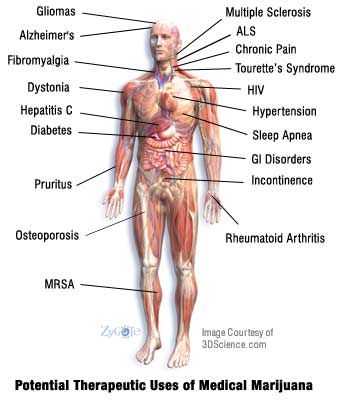
Someone once said to me,
"the further you get away from the facts, the easier they can turn into a myth."
Boy, is that the truth.
It all started three years ago when I decided to finally research marijuana. If anything, I was determined to prove to myself and others that my concerns were valid. Living in Colorado where medical marijuana was legal to possess and grow once you qualified for a "red card", I was surrounded by "pot shops."
Thanks to Amendment 20 in our State Constitution, these dispensaries grew and flourished faster than it takes a medical marijuana bud to mature. In Denver County alone, there are around 400 medical marijuana dispensaries, outnumbering the 375 Starbucks statewide. I freely admit that I mocked these businesses and rolled my eyes at the people who frequented them.
So, on that summer day nearly three years ago, I decided to dig into this controversial plant and arm myself with even more information that would support my anti-marijuana stance.
But a strange thing kept happening. The more I dug into what some opponents refer to as "the green menace," the more I continued to find research studies I wasn't aware existed. Some of these studies had been buried - perhaps purposely - and made scientific claims about Cannabis Indica and Cannabis Sativa that I found almost too good to be true.
For example, I read a 1974 study (published in 1975) that was conducted at the University of Virginia that proved that the cannabinoids in the cannabis plant shrunk cancerous tumors and killed cancer cells, leaving healthy cells alone.
Even though it was there in black and white, I still didn't buy it. So I kept investigating.
I found that when I used the Internet search terms "cannabis+indica+healing+benefits," I got a whooping 220,000 websites.
When I added the word "medical" to that group of words, the field increased to 452,000.
For the next six months, I spent every spare moment researching "the Devil Weed." Putting it bluntly, I was shocked. There was absolutely nothing "devilish" about it. All this remarkable information had been out there, waiting to be discovered and all I had to do was agree to view it with an open mind.
I learned that Cannabis Indica had been compounded into liquid extracts in the late 1800's and up until the early 1900's. These extracts were recommended by medical doctors to alleviate everything from teething pain in infants to reducing the pain of arthritis and menstrual cramps.
I found out that contrary to what I'd been told, nobody has ever died from using marijuana in the thousands of years this plant has been available. In fact, I had no idea that its medical use dated back to around 2700 B.C. and was called a "superior" herb by the Emperor Shen-Nung (2737-2697 B.C.)
I discovered that while I had been demonizing marijuana, thousands of people worldwide had been quietly and effectively curing or relieving a multitude of health problems, including,
- Crohn's disease
- migraine headaches
- chronic depression
- post traumatic stress disorder (PTSD)
- insomnia
- dementia
- epileptic seizures
- Parkinson's disease
- even AIDS
The more I researched and talked to pro-cannabis physicians, patients, researchers and historians who studied the plant, the more I heard incredible testimonials of recovery from illnesses and mental imbalances in addition to, as one patient told me,
"just a better outlook on life."
And that's when I uncovered information that really challenged the stories I'd been told.
People were using this "weed" to get off of opiates, alcohol, tobacco, heroin, cocaine and other powerful drugs. Thus, it was gaining traction as "an exit drug," instead of the "gateway drug."
Seniors were also secretly using it to improve their cognition. Wait...what? How is that possible? Didn't marijuana make you a "brain-dead loser"? No, not according to the scientific data I discovered.
The opposite was true as researchers found that the plant allowed neurogenesis in the brain - the growth of new neural pathways, even when the brain had been damaged by age or trauma.
I understood that smoking the herb was the least effective way to gain the vast array of medical benefits from its use. I learned that doctors, lawyers, CEOs of major companies, accountants and other highly trained professionals used marijuana daily and felt it vastly improved their wellbeing and ability to handle stress.

I found out that a respected medical doctor, Dr. William Courtney, encouraged patients with chronic illnesses to juice 10 to 20 fresh marijuana leaves daily. This concentrated green drink was not psychoactive and flooded the body with cannabinoid nutrients that helped reverse degenerative diseases.
Putting it mildly, the information was mind-boggling. And that's when I realized that there was a story to be told. Nobody had ever written a fictional novel about medical marijuana that didn't include "stoner" stereotypes or pander to fear.
It took me another five months and hundreds of hours of one-on-one interviews with medical marijuana patients, caregivers, growers, dispensary owners and experts within the cannabis industry to develop what would become Betty's (Little Basement) Garden.
The book focuses on 58-year-old Betty Craven, a strikingly beautiful former Texas beauty queen who is a staunch Republican and widow to her equally conservative career military husband, Frank. Betty's only child, a son, died in his mid-20s from a drug overdose. When we meet Betty, her life is in suspended animation. The walls are closing in around her.
All she has left that she loves is her award-winning flower garden and the remnants of equipment left over from her failed gourmet chocolate store. When she comes to the shocking conclusion that her entire life has been wasted, a rebellious spirit that Betty has kept hidden, explodes to the surface.
Her conservative world spins 180 degrees around as she comes face-to-face with her biggest fears. And one of those fears is marijuana.
The path she chooses is paved with secrecy, eccentric characters, toe-curling love, life-changing events, and a connection to her unconventional, basement garden that she never could have imagined.
My intention when I wrote Betty's (Little Basement) Garden was to show the truth about the medical marijuana industry in Colorado.
It's not all sunshine and lollipops. I don't sugarcoat the realities of working in the cannabis world, nor do I romanticize what it means to be a grower for a seriously ill patient who depends upon your green thumb to make his or her medicine.
The book illustrates a massive shift in the "anti-pot" propaganda that I grew up hearing and believing. My hope is that it's not just an entertaining story; my hope is that it's also enlightening for those who read it and believe the way I used to about this ancient herb.
As Betty Craven says,
"There's nothing more liberating than releasing a limiting belief."
To read or download an extensive, 840 page compilation of published medical studies that show the proactive use of cannabis in various forms, please read "Cannabis - A Remarkably Safe and Effective Herbal Medicine - Granny Storm Crow's MMJ Reference List - July 2012"
Hemp matures in as little as 100 days. Trees mature in 50-100 years.
One acre of industrialized hemp is as profitable as 5 acres of trees.
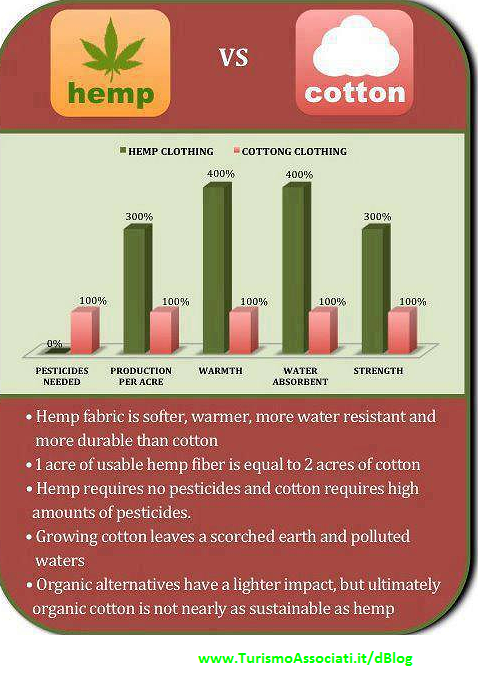
Hemp crops can yield up to 10 tons per acre of fiber per acre, every 4 months. This is 4 times what an average forest can yield.
Hemp paper can be recycled up to seven times. Wood pulp paper can be recycled four times.
|